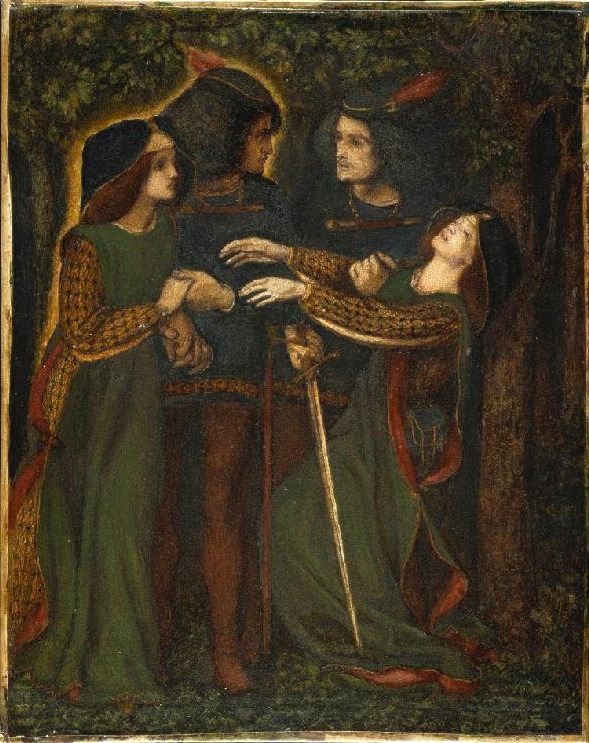Folklore crackles with tales of spirits and doubles. These bad omens, like the Bean Nighe, point to the death of the beholder. Irish folklore also features the fetch, a shadowy double who appears at the point of death.
According to the folklore, the fetch appears to a third person just as someone dies, or is about to. This witness believes it to be the person they know – except the person should be many miles away at the time.
Some stories claim the fetch disappears down hallways or alleys if a mortal tries to follow it. It’s not a ghost. It’s just a copy of the original person. No one knows why it takes that form, and it’s rarely malevolent in nature.

Georgia Dunham Kelchner defines the fetch as “the inherent soul, the accompanying counterpart or representation, of a living person” (2013 [1935]: 17). So at the point of death, that soul travels beyond the body and appears to a loved one. Whether it’s through panic or to give reassurance, no one knows.
For Andrew Black, “[t]he Fetch may even bear the signs of how the person will die. The movie series Final Destination could be considered to be about an elaborate Fetch scenario, and much like in the films, the victim will usually die as predicted by the Fetch, if not in exactly the same manner” (2012).
But, as with all things folklore, it’s not that straightforward. If a person sees a fetch in the morning, they will have a long life. Yet if the apparition appears at night, the person faces a swift death. Ouch.
Let’s find out more about them!
Where does the name come from?
‘Fetch’ is largely an Irish term but English antiquary and lexicographer Francis Grose claimed it as a northern English term in his Provincial Glossary of 1787. J.L.L. notes that “there is no accounting for the coming of this forerunner of death, there is no tracing it to any defined origin” (1834: 342). Some believe it refers to a figure who “fetches” souls.
The fetch appears in most English folklore from the 18th century onwards as the double. I wrote about doubles and doppelgängers over on the Folklore Thursday blog so you can read more about those there. And doubles shouldn’t be confused with folklore about reflections.
This concept also made its Irish literary debut in the early 19th century. It popped up in an 1825 story “The Fetches” by John and Michael Banim. The concept actually dated to a ‘true’ English ghost story published in 1705.
“The First Modern Ghost Story”
Roger Clarke discusses this tale in his book, A Natural History of Ghosts: 500 Years of Hunting for Proof. In it, Mrs Margaret Bargrave sat at home in Canterbury one September day. As the clock struck noon, her friend, Mary Veal came in. They chatted for a bit, with Miss Veal consoling Mrs Bargrave about her “marital discord” (2013: 106). She then asked Mrs Bargrave to write some letters for her, including instructions about who should get items from her jewellery collection.
Almost an hour and three quarters passed before Miss Veal finally took her leave. It no doubt came as quite a shock when Mrs Bargrave discovered the next day that Miss Veal died, right around the time she popped in for tea.
This story actually comes from an anonymous pamphlet, published in 1705. Its full title is A True Relation of the Apparition of one Mrs. Veal, the next Day after her Death: to one Mrs. Bargrave at Canterbury. The 8th of September, 1705. Many attribute it to the writer Daniel Defoe, and Robert D. Stock notes its place as “the first modern ghost story” (1982: 92).

The tale also aims for a sense of realism absent from earlier stories. The narrator assures us he knows Mrs Bargrave personally. He can “vouch for her reputation” (Owens 2017: 95). This helps us to feel as though the story may really be true. It appears to have happened to someone the author knows. The book is available from Project Gutenberg.
This story is also important to the development of ghost stories. It lacks a moral, as previous ghost stories had had. The ‘twist’, that Mrs Veal was actually dead at the time of the visit, replaces the need for a moral. The author also provides a back story, in which “both women had suffered parental neglect or unkindness as children” (Owens 2017: 96). This psychological baton would later be picked up as part of the Gothic storytelling mode.
A Popular Tale
It’s unlikely that Defoe invented the story; rather, it perhaps came from a popular form of tale passed among the population. Different variations exist around the British Isles. These stories also appear in popular anecdotes, particularly favoured by ghost hunts and walking tours. The format is always the same. Person A speaks to or sees Person B. They later discover Person B died at the time they saw them, often many miles away.
Indeed, one version situates the story in St Andrew’s Churchyard in Newcastle upon Tyne.

Here, the sexton had a sweetheart named Charlotte. They argued and parted bitterly. Eventually, the sexton decided to call on her and apologise. As he locked up the church one evening, he spotted her in the graveyard. She moved among the tombstones, wearing her favourite blue dress. The sexton smiled – Charlotte had come to see him! He could apologise and all would be well.
Or would it? He called out to her and she ignored him, disappearing into the shadows. He couldn’t find her in the churchyard so he went home, confused about what had happened. The following day, he hurried away to her house to call on her. When he arrived, the shades were drawn, and the house quiet. One of the servants told him that poor Charlotte died the day before, at the exact time the sexton saw her. She wore her favourite blue dress at the time.
The Fetch and the Fylgja
The fetch bears some similarities to the Norse concept of the fylgja. Unlike the fetch, the fylgja didn’t represent specific people, but still acted as a portent of death. Well, sometimes.
The word ‘fylgja’ translates as ‘to accompany’. So for some people, the fylgja takes an animal form, based on the first animal to appear after a birth. It ‘accompanied’ a person throughout their life. A bit like the daemons in Philip Pullman’s His Dark Materials trilogy.
I was born during the witching hour so who knows what my fylgja would be? Probably a bat. That says a lot.

Others believed the fylgja to be whatever animal ate the afterbirth. So lots of them took the form of carrion animals. Some even believed the type of animal indicated the personality of the person.
Seeing your own fylgja apparently heralded your death…unless it appeared as a woman, in which case you could expect good luck. Female fylgjur were considered a good luck sign for a family.
Famous Fetch Encounters
There are various examples of famous people having apparently seen a premonition of their own death. Abraham Lincoln reported a dream that appeared to foretell his assassination. Elizabeth I allegedly saw a corpse on her bed. Somehow she summoned the strength to get closer and she recognised the corpse. It was her. She died soon after.

This isn’t the same as a fetch. The fetch appears at the point of your death to someone else. It isn’t a premonition because at that point, there’s nothing you can do about them.
The 16th-century English poet John Donne apparently saw his wife’s fetch in Paris. The apparition held a newborn baby, but Donne knew it heralded nothing good. He learned his wife had given birth to a stillborn child at the time he saw the fetch.
Is the fetch a death omen?
I know what you’re thinking. If the fetch is a death omen, why don’t we see one every time a person dies? J.L.L. has a possible answer for that: “It is most frequently thought to be seen when the fated object is about to die a sudden death by unforeseen means, and then it is said to be particularly disturbed and agitated in its motions” (1834: 342).
They’re also not an omen of your death…unless you happen to see your own.
But they do herald the death of someone you care about elsewhere, and they don’t even need a banshee to announce it…
Have you ever heard any fetch stories? Let me know in the comments!
References
Black, Andrew (2012), ‘Know Your Ghosts: The Fetch’, The Mask of Reason, https://maskofreason.wordpress.com/2012/09/08/know-your-ghosts-the-fetch/.
Clarke, Roger (2013), A Natural History of Ghosts: 500 Years of Hunting for Proof, London: Penguin.
J. L. L. (1834), ‘Popular Tales and Legends’, The Dublin Penny Journal, Apr. 26, 2:95, pp. 341-344.
Kelchner, Georgia Dunham (2013 [1935]), Dreams in Old Norse Literature and their Affinities in Folklore, Cambridge: Cambridge University Press.
Owens, Susan (2017), The Ghost: A Cultural History, London: TATE.
Stock, Robert D. (1982), The Holy and the Daemonic from Sir Thomas Browne to William Blake, Princeton, NJ: Princeton University Press.
Nutty about folklore and want more?
Add your email below and get these posts in your inbox every week.
You'll also get my 5-step guide to protecting your home using folklore!







My father in law told me during ww2 that he was woken by a noise. He saw in front of him his uncle who was away fighting the war. He told him go back to sleep everything is o k. He asked why are you here and again he said it is o k just go to sleep. The next day the news arrived that he had been killed the day before in battle. He told his parents what had happened the previous night and they said it was probably a night mare.
Wow, that’s amazing. Definitely sounds like a fetch!
Just curious if a fetch has ever been just a disembodied voice. There are many stories involving only the women in my family for generations hearing the voice of a loved one call their name and come to find out that same person who called out had passed or had a near fatal accident. Granted a fetch doesn’t quite fit but it made me think of those stories. I’ve never heard a proper term for it. My great grandmother just called it a warning, but she was vague about most supernatural things. She never said ghost or spirit she merely referred to such events as “something you were meant to see” or, “something for you to hear” and “that time will tell the reason why just wait.”
I don’t know if this counts as a Fetch. After my father died and had been buried, he appeared to my sister and spoke with her at night about how he loved her and she shouldn’t be sad. She said he seemed real and was not a scary ghost-like figure.
Fetches don’t always talk, so that might have just been a visitation. But definitely a welcome one!
The war poet Wilfred Owen appeared to his brother in the Middle East at the moment of his death on the Western Front. The brother said later that he woke and saw Owen looking sadly at him and the figure faded away. He assumed it was a dream until the notification of Owen’s death came through.
My grandfather told us of how his brother s spirit appeared to his mother. The brother was away in Dublin and had been run over in a traffic accident. The never used the word fetch but the discription matches what occured.
Yeah, that absolutely sounds like a fetch!